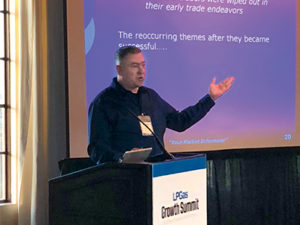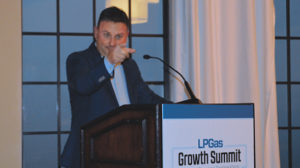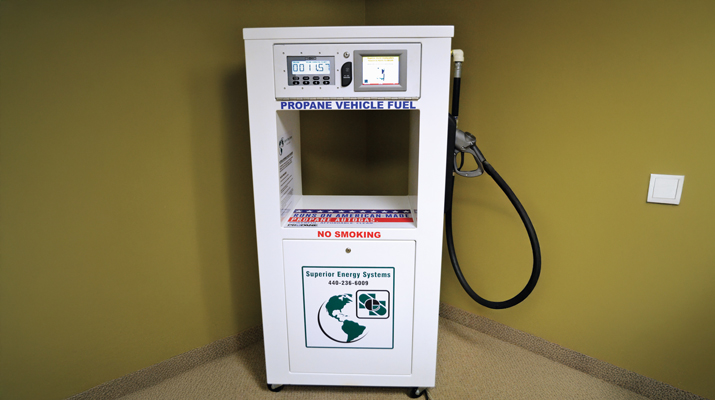Supply challenges and the gallon challenge

Dale Delay at the 2019 LP Gas Growth Summit. Photo: LP Gas
Supply and the future success of the propane industry: These are two topics that are top of mind for propane retailers.
Dale Delay, president of Cost Management Solutions, and Randy Thompson, founder and senior adviser of ThompsonGas, addressed both topics during respective presentations at the 2018 LP Gas Growth Summit.
Navigating supply
Delay first examined the closing prices of crude oil and propane prices from Sept. 10 through Oct. 26 to show crude oil prices dipping $10 and Mont Belvieu prices dropping 18 cents.
“If you were sitting on some good price buys coming into this,” Delay says to the group, “they have taken a hit.”
Not long after the peak of Mont Belvieu prices toward the beginning of October, a producer came into the marketplace to sell its 2019-20 production, which was cause for a large fall in price.
“The propane marketplace cannot handle big sellers unloading a lot of volume at once,” Delay says. “We are not that large of a market.”
Refinery utilization – the rates of U.S. refinery usage – usually drops from early October to sometime in November every year, causing a general weakness in crude prices.
“As we get lower utilization, crude inventories build and then prices go lower,” Delay says. “Anytime you start building inventories, are you worried about supply? In a period of inventory builds, the market worries less about supplies. So, what are you going to do? You are going to push the price down.”
Delay says this is common for the market around this time of year. So common, Cost Management Solutions calls it the “October peak and the November pullback.”
Delay suggests that propane is not a good commodity to trade. However, it is good to hedge. He adds it’s better to trade heating oil and crude oil.
To explain this, Delay uses the example of a 2-cent difference between a bid (the buyer’s asking price) and the ask (the seller’s asking price). Delay admits it does not sound like a lot, but 2 cents adds up over gallons. On a 400,000-gallon trade, that is an $8,000 difference.
“Smaller markets and fewer traders result in inefficient markets,” Delay says. “It is important to realize how small the propane market is.”
Delay suggests retailers learn from successful traders and use short-term indicators in their supply strategies. He also notes that price indicators, like moving averages and relative strength indicators along with their view of supply/demand, can assist retailers in hedging efforts.
The Gallon Challenge

Randy Thompson talking about his gallon challenge during the 2018 LP Gas Growth Summit. Photo: LP Gas
Thompson, the chairman-elect for the National Propane Gas Association, laid out his goal of growing the propane industry by 4 billion gallons in five years.
Thompson first presented his goal this past summer at the Propane Education & Research Council (PERC) meeting in Minneapolis.
“I laid out this very high-level goal and it was to grow the industry by 4 billion gallons in five years,” Thompson said to the LP Gas Growth Summit attendees. “I got a lot of nodding from the PERC council members. They talked about it the next morning during a private session and it’s really starting to get some traction in the upper circles of our industry leaders.”
As part of his Growth Summit presentation, Thompson explained several avenues by which the industry can achieve this goal, including water heaters and autogas applications.
Thompson estimates 4 to 5 million propane customers do not utilize propane-powered water heaters. If the industry can convert just half of those customers, Thompson explains, the gallons sold for those water heaters would be close to 1 billion. A major step toward accomplishing this would be to convert customers’ water heaters from electric units to propane, particularly before their current electric water heater breaks.
Autogas is another avenue the industry can pursue to reach the 4-billion-gallon growth mark.
“Right now, we are achieving 6 to 7 percent of the school bus fleet market in the United States,” Thompson explains. “If we can get that number up to about 30 percent in five years, that is another half a billion to three-quarters of a billion gallons.”
A largely unknown avenue to gallon growth is on-site power for military bases. Thompson explains a U.S. Department of Defense mandate says every military base in the United States needs to have two weeks’ worth of on-site power capability by 2025. If propane retailers can draft an agreement with the government to guarantee propane purchases for these bases up to a certain amount, the industry can grow in a sector not currently explored.
Thompson compared his 4-billion-gallon plan to a Chinese bamboo tree. This particular seed requires five years’ worth of nurturing before it breaks through the soil. Once it sprouts, the tree grows 90 ft. in five weeks.
Thompson asked the Growth Summit attendees if the tree really grew in the five-week span or during the five years of hard work.
Thompson likens the five years’ worth of nurturing to the 4-billion-gallon growth in five years he hopes to accomplish.
“This is what I am challenging this industry to do,” Thompson says. “It is to be patient, be aggressive and be strategic. We can do this if we all put our minds to it.”
















